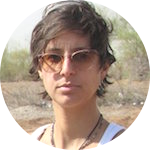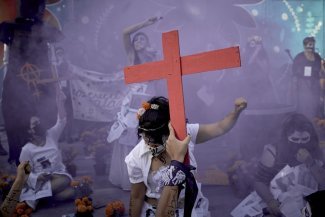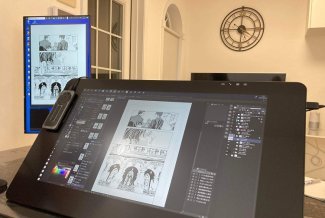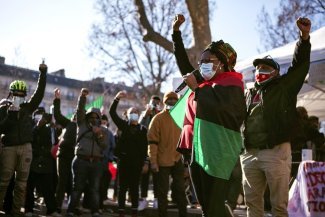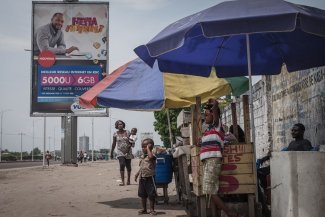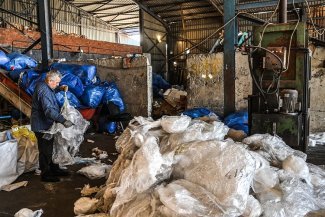Former child soldiers learn the Brazilian martial art of capoeira at the CAJED transit center in Goma, North Kivu, Democratic Republic of Congo.
It’s a Thursday afternoon in Keshero, a community on the outskirts of Goma, the capital of North Kivu province in the Democratic Republic of Congo (DRC). A group of children and young people assemble in an open space at a transit and orientation centre (CTO) for former child soldiers run by the Concert d’Actions pour Jeunes et Enfants Défavorisés (CAJED, or Concert Action for Disadvantaged Children in English).
Around 70 boys, 30 of which are former child soldiers, start forming a circle as they get ready to practice a very special activity: capoeira. Every Tuesday and Thursday they take part in a two-hour class of the Brazilian martial art that combines dance, music and chanting, and originates from enslaved west Africans in 16th century Brazil. Boys as young as five and teenagers as old as 17 gather to the sound of a single-string percussion instrument named berimbau.
“Ieh capoeira!” greets the Brazilian capoeira master Flavio Saudade in a traditional capoeira salutation before beginning the class. Those who have been taking classes for some time show the newcomers how to behave in the roda, the circle where the ginga (the basic swinging) and other capoeira movements take place in a form of non-violent combat.
Prior to the warm-up, everyone is supposed to leave their shoes in a corner, salute the capoeira masters and ask for permission to join the roda. This ritual helps to create discipline, respect and a collective feeling of belonging, says Saudade. “You have to follow the rhythm set by the berimbau. Do not rush, we are all brothers here,” he tells the children, who listen to his words with great curiosity and attention.
“With capoeira, they learn how to forgive themselves,” says Saudade.
One of the world’s deadliest conflicts
North-eastern DRC has been mired in armed conflict for more than 20 years. Following the 1994 Rwandan genocide, Hutu extremists who perpetrated genocidal crimes fled across the border where they joined forces with the Congolese/Zairean army in an offensive against Congolese Tutsis in the eastern part of the country.
What followed was one of the deadliest conflicts since the Second World War, involving five other African nations (Rwanda, Uganda, Angola, Namibia and Zimbabwe), fuelled by Congo’s multi-trillion dollar mineral resources, and resulting in over six million deaths.
Although the war was officially declared over in 2003, eastern DRC remains the theatre of complex and prolonged violence and instability. Recent numbers indicate that 7.3 million people in the region still need humanitarian assistance while some 3.8 million people are internally displaced – the highest number in Africa, according to the United Nations Office for the Coordination of Humanitarian Affairs (OCHA).
Of the dozens of armed rebel groups still fighting in eastern Congo, many have recruited children – often forcibly – as active combatants, porters, spies or sex slaves. Since 1998, tens of thousands of children, known locally as kadogos or ‘little ones’, have been involved in the conflict in eastern DRC. After being brutally separated from their families, children undergo serious physical and psychological trauma. For Saudade, capoeira can go some way towards helping them to heal as a means of promoting lasting peace.
“Once we fought against one another”
Capoeira classes have been held at CAJED Goma since August 2014 as part of the Capoeira pour la Paix (Capoeira for Peace) initiative led by the governments of Brazil and Canada, and the Monaco-based children’s charity AMADE-Mondiale with support from UNICEF.
The ultimate aim of the classes is to improve the self-confidence of the young participants, while helping them to overcome the significant trauma they have endured.
Sixteen-year-old Bestbrice (not his real name) used to be a member of the Congolese Hutu armed group, the Nyatura, in Masisi which is 80 kilometres northwest of Goma. For the last four months he has been one of 30 unaccompanied minors waiting at CAJED Goma to be reunited with his family or to find a new host family. When asked about what he likes most about his new life, he says “capoeira” without hesitation.
“Capoeira makes me feel like I am capable of doing something. It makes me forget all about the past. When we play the movements, it is very peaceful and it helps me to build friendship with the others,” he tells Equal Times.
Bestbrice says that since he started capoeira, he has made a lot of new friends. “At first, I was not really interested,” he admits, laughing. “But as the days went by, I felt it was a good thing. No one obliges you to do anything. We are all together even if we once fought against one another. What attracts me is that capoeira helps us to build friendship,” he says.
This young teenager has lived through shocking scenes of war while surviving in the bush under immense psychological stress. “During the time I was with the armed group, there were a lot of difficulties we had to go through,” he says without going into too much painful detail.
The Nyatura was founded in 2010. It is one of numerous mayi-mayi, community-based militia formed to defend local territory against other armed groups. Like most of the other militias, the Nyatura has been accused of human rights violations such as summary executions, rapes, causing forced displacement of civilians and the recruitment of child soldiers.
Ending the phenomenon of child soldiers
Today, Bestbrice is one of more than 20,000 child soldiers that has been freed from armed groups in the DRC, according to a report released by UNICEF this February. But many more children remain ensnared.
“A child’s place is not in armed groups,” Faustin Lyabahinduka, the director of CAJED, tells Equal Times. “The problem we have here in Congo is the phenomenon of child soldiers that started after the [genocide] with the massive inflow of Rwandans.”
CAJED runs six transition centres in North Kivu through which some 10,000 children have being received since it was created over 20 years ago. But ending child recruitment is a difficult task, says Lyabahinduka.
“We also do sensitisation work deep in the province with teams reaching local leaders of armed groups in order to try to convince them to release any children. Some groups do release them, other children manage to escape.”
Once a child flees from an armed group, they search for help in local centres run by NGOs or outposts of the UN peacekeeping mission MONUSCO.
“We need to confirm whether the ones who escape are indeed under 18 years old. Once they are verified they come to the transition centres to receive child protection assistance. The minimum period they stay in the CTOs is three months,” he says.
An average of 100 children per month receive help in the 45 verification centres spread through North Kivu, a province with an estimated population of 7.1 million, 2.9 million of which are under 16 years old according to the National Electoral Commission.
Bestbrice dreams of being reunited with his family again. It has been several months he lost track of his father. “I don’t know if my mum is still alive. I never met her. From what I know, my father could be in Rwanda. I hope he accepts me back. Meanwhile, I will stay here in CAJED until I find my family”.
Bestbrice says he dreams of finishing his studies and one day being able to find a job. In the meantime, he will keep attending capoeira classes. “I want life to continue.”



